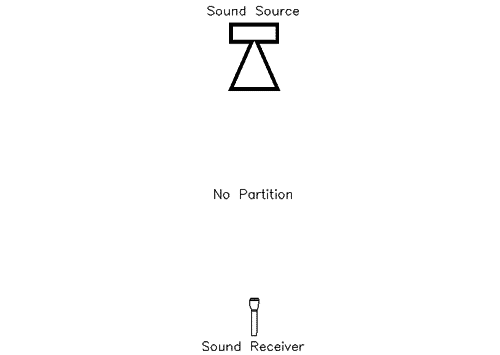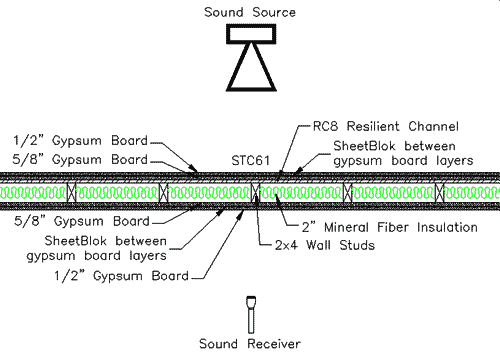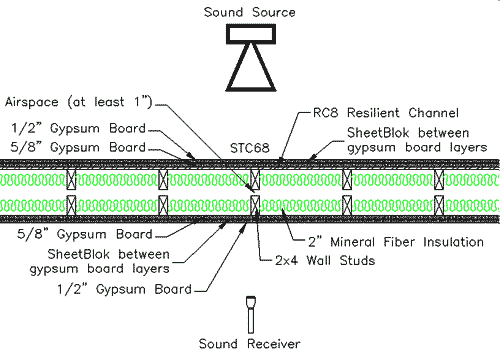 |
|||
 |
|||
| OK, so you've read through Acoustics101.com and all our FAQs. Still unsure about what construction is right for you? Well, hopefully this page can help. We've assembled some WAV files for you to listen to that should help put into perspective the different levels of acoustical isolation that are possible. In case you haven't read through Acoustics101.com and/or our FAQs, some basic things you need to know: · Foam cannot stop sound from going through your wall. · Construction to some degree will be necessary to improve your acoustical isolation significantly. Having established that, why don't we get started? Step 1: Setup for the listening examples. 1. Play the following WAV file - preferably through a decent sound system and not your PC speakers - and turn the volume up until it's uncomfortable. The desired effect is that you feel you are "in the room" with the band. (Note: Please do not turn the volume up so high that you damage your equipment and/or your hearing. It is necessary for the demonstration for this file to be loud, but we cannot be held responsible for any damage to your equipment or hearing.) 2. Do not adjust the volume for any of the other WAV files on this page. Once you've set up the volume in Step 1, that is your reference. Provided you do not adjust the volume, you will be "AB-ing" different materials and construction relative to the "No Partition" file. Step 2: SheetBlok Versus Gypsum Board Comparison. The following two WAV files demonstrate the differences between one (1) layer of our SheetBlok sound barrier and one (1) layer of ½" gypsum board ("drywall", "sheetrock"). SheetBlok has an STC of 27. Gypsum board (1/2") has an STC of 28. Therefore, it would make sense if the gypsum board stopped more sound. However, listening to the WAV files illustrates the additional low frequency attenuation available by using SheetBlok. As is explained in the STC FAQ, STCs don't always tell the whole story about the broadband differences between acoustical barriers.
Step 3: Real Wall Comparison While comparing SheetBlok and gypsum board is all fine and grand, you are not likely to build a wall consisting of a single layer of any material. Therefore, the following two WAVs are presented to illustrate the difference between a typical wall construction - ½" gypsum board on both sides of uninsulated studs - and a "beefed up" construction which adds a layer of SheetBlok to one side and an additional layer of gypsum board over the SheetBlok.
Step 4: Ideal, "Single Wall" Construction For the best results in a retrofit type situation, we suggest tearing out the drywall, insulating between the studs with 2" Mineral Fiber, adding resilient channel to one side, and then finishing with gypsum board, SheetBlok and gypsum board on both sides of the wall. The following WAV is a sample of the results you might expect from such an improvement in the construction. (Note: Similar results are achievable with standard fiberglass batts or "blown-in" fiberglass or cellulose. The best results will be gained using Studio-Grade Mineral Fiber Insulation.) Step 5: Ideal, "Double Wall" Construction For the best possible results, we suggest in www.Acoustics101.com to pursue double wall or "room within a room" construction. The following WAV illustrates the significant increase in STC that is attainable with this type of construction. (Note: You may have to put your ear to the loudspeaker to verify that the file is actually playing. Feel free to compare the WAV in Step 1 with this one. The results are quite dramatic. Just don't keep your ear by the loudspeaker when switching back to the WAV in Step 1!) We hope these demonstrations have helped you make some decisions about what you'd like to do in terms of construction for your room(s). Should you have any questions, you can e-mail our consulting division - consulting@auralex.com. Thank you again for your attention! Special Note: All the WAV files contained on this page were simulated using data that were obtained from tests conducted in accordance with ASTM E 413. Your results will vary depending on the actual conditions of the existing structure and/or the quality of the new or improved construction. |
|||






